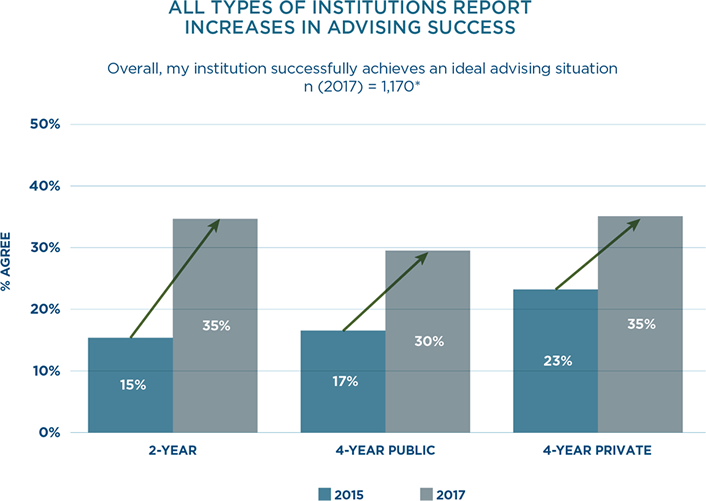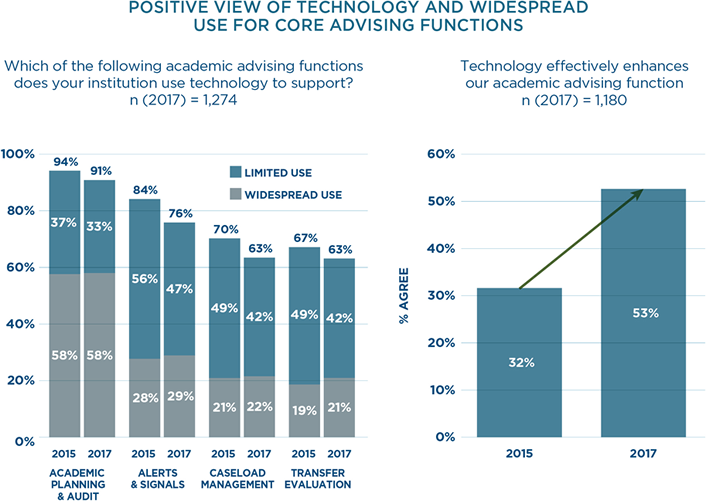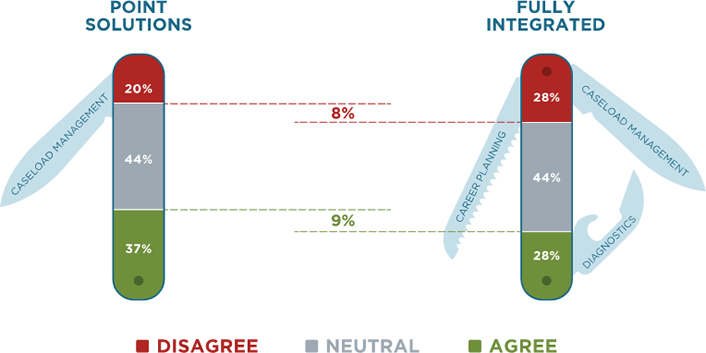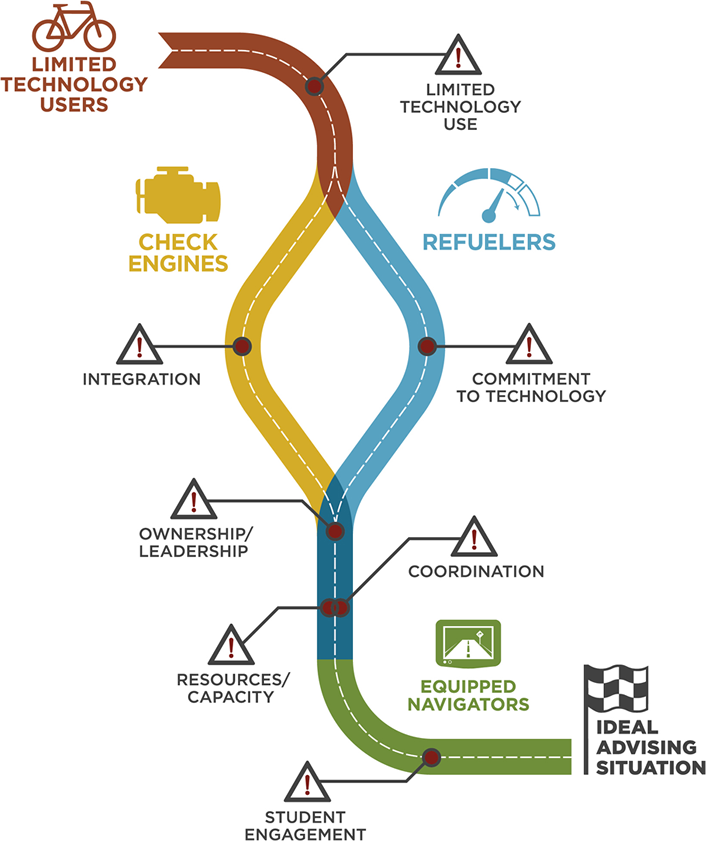
Adapted and excerpted from Driving Toward a Degree, 2017
For many institutions, the redesign of academic advising is at the center of improving student outcomes. Tyton Partners recently launched Driving Toward a Degree 2017: The Evolution of Academic Advising in Higher Education, the latest report in a series that measures the extent and impact of various practices and products related to academic advising across higher education institutions nationwide. In this post, we share the following highlights, which draw from a primary research survey of over 2,200 administrators and advisors across 1,400 institutions (including interviews with 40 leading suppliers):
- Institutions believe they are improving advising on campus. The percentage of institutions with respondents who believe they are achieving an ideal advising situation has grown, up from 20% in 2015 to 34% in 2017 (see figure 1).
- Five elements of redesign — leadership, advising capacity, advising coordination, technology, and student engagement — emerged from our analysis of the 2017 survey results. These elements to improve advising vary in importance and impact based on where an institution currently is on the road to ideal advising.
- Based on respondents' perspectives and attitudes toward advising and technology use, four institutional segments emerged: Limited Technology Users, Check Engines, Refuelers, and Equipped Navigators. Institutions can locate where they are on the road to ideal advising by benchmarking themselves against peer institutions according to institutional segment. These benchmarks act as standards or points of reference, allowing institutional leaders to discover the best advising performance being achieved and understand what barriers are preventing the institution from equaling or exceeding the best in class.

Headed in the Right Direction
In addition to improvements in overall success, institutions likewise cite improvements in the clarity of ownership of advising and cross-departmental collaboration. Moreover, significantly more institutions report that technology effectively enhances their advising function (see figure 2).

However, adoption of core solutions that support advising does not seem to be the key driver of improvements, as adoption rates for degree planning, case management, alerts and signals, and transfer evaluation products have remained constant. New products have emerged, including return on investment (ROI)/resource allocation tools that can help institutions best direct efforts to both forecast course demand and improve advising. (Download the 2017 report at drivetodegree.org to read more.)
Yet institutions using fully integrated technology solutions — much like Swiss Army knives — struggle to realize the promise of such a solution that dramatically improves academic advising (see figure 3). These institutions are less likely to report overall success with their academic advising functions. During the course of our conversations, we've found that aligning expectations around impact of technology and redesigned process remains an enormous challenge for institutions and suppliers.

Based on this research, institutions using what they perceive as fully integrated solutions are more likely to feel that technology does not enhance their advising function. This contradicts the advertised benefits of integrated functionality (that it eases the pain of managing multiple products). These negative views have been influenced by institutions' experiences with specific products they have adopted. Institutions using fully integrated solutions are less likely to report satisfaction with their products.
While the market has developed considerably since we began tracking advising and student success technology, the integrated solution is not yet robust or customizable enough to fulfill all institutions' needs. Instead, institutions that pick and choose from a menu of point solutions are better able to tailor those products and subsequently are more satisfied. Will suppliers overcome these issues? Perhaps, but for the concept of an integrated solution to really take hold, institutions will also need to think about how to overcome their own organizational silos so that the requirements for success are not merely the sum total of the wish lists from each silo.
The Redesign Roadmap
We've reengaged with several suppliers in the student success technology arena at events sponsored by EDUCAUSE, NACADA, and others these past few months, and we continue to see ongoing developments in pursuit of a more integrated, coordinated, and well-connected advising and student support experience enabled by technology. In our view, suppliers' speed of improvement and evolution exceeds institutions' ability to manage process redesign and other institutional change efforts. While it is exciting to be attracted to the latest and greatest functionality, the best improvements often come from better adoption and use of what's already in place, along with a relentless focus on improving the student experience. For institutions, redesigning academic advising to improve student persistence and success requires a sustained internal effort across five key elements: leadership, advising capacity, advising coordination, technology, and student engagement (see figure 4).

On the Road to Ideal Advising
Since our first survey in 2015, there has been considerable movement among the four institutional segments that we identified. These segments differ in advising outcomes and approaches to technology using a cluster analysis of five key variables, including stakeholder attitudes on advising ownership, coordination, technology use and effectiveness, and overall success.
- Equipped Navigators (21% of institutions surveyed): Possess a positive view of advising success and have strong ownership, alignment, and coordination on student success initiatives.
- Low Fuel ("Refuelers") (20%): Favor people over technology as a solution for advising. Increasingly see themselves as successful in advising and report rising levels of collaboration and clarity of ownership.
- Check Engines (24%): Do not view themselves as having yet achieved success. Favorable toward technology adoption to improve advising, but struggle with technology integration and lack strong ownership and coordination.
- Limited Technology Users (35%): Do not report widespread use of any advising technology.
For 2017, Limited Technology Users have grown as a share of the total respondents, while Equipped Navigators have shrunk. Of note, every segment reports more success than two years ago. Gains varied between segments, (e.g., Check Engines barely budged, and Refuelers — previously called Low Fuels — leaped forward).
Each institutional segment represents a point on the road toward an ideal advising situation (see figure 5). In some cases, an institution may have encountered a detour, such as lack of clear ownership, and now needs to get back on the road to success. Other institutions have barely begun the journey and are not yet prioritizing advising as a path toward improving student outcomes.

Even Equipped Navigators, who report a high level of success and share solid ownership and coordination, may encounter hazards going forward. For example, Equipped Navigators are overrepresented among institutional adopters of technology. However, as mentioned above in our Swiss Army knives metaphor, the adoption (and integration) of technology does not automatically result in greater success; people and processes matter, too.
Where Are You on the Road to Ideal Academic Advising?
Visit drivetodegree.org to take our self-assessment to find out. Download the 2017 report to learn more about what barriers are preventing improved institutional performance and student outcomes and to gain insight into the present and future states of technologies for integrated academic advising.
Gates Bryant serves as a partner of Tyton Partners' strategy consulting practice.
Nicholas Java serves as a principal of Tyton Partners' strategy consulting practice.
© 2018 Gates Bryant and Nicholas Java.
